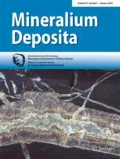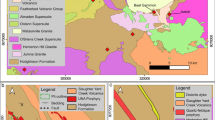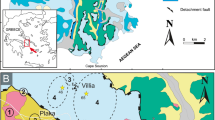Abstract
Stannite and sphalerite coexisting with iron sulfides (pyrite and/or pyrrhotite) from Japanese ore deposits associated with tin mineralization were analyzed. Based on the iron and zinc partitioning between stannite and sphalerite, the formation temperature and sulfur fugacity for this mineral assemblage were estimated. A good correlation between stannite-sphalerite temperatures and filling temperatures of fluid inclusions and sulfur isotope temperatures was obtained. This good correlation suggests that the stannite-sphalerite pair is a useful indicator of temperature and sulfur fugacity. It is deduced that the formation temperatures are not different for skarn-type, polymetallic vein-type and Sn-W vein-type deposits, whereas the sulfur fugacities are different; sulfur fugacities increase from the skarn-type through the Sn-W vein-type to the polymetallic vein-type deposits.
Similar content being viewed by others
References
Barton, P.B., Jr., Skinner, B.J.: Sulfide mineral stabilities. In: Geochemistry of Hydrothermal Ore Deposits, 2nd Edition, H.L. Barnes, Ed., pp. 278–403 New York: A Wiley-Interscience 1979
Boorman, R.S.: Subsolidus studies in the ZnS-FeS-FeS2 system. Econ. Geol. 62:614–631 (1967)
Enjoji, M., Nedachi, M.: Fluid inclusions in the minerals from the Kano mine, Miyazaki Prefecture (abstr.). Joint Meeting of Soc. Mining Geol. Japan, Assoc. Miner. Petr. Econ. Geol., and Miner. Soc. Japan, C-38 (1983) (Japanese)
Enjoji, M., Shoji, T.: Fluid inclusion study on the Tsumo skarntype deposit, southwestern Japan. Mining Geol. 31:383–396 (1981) (Japanese with English abstr.)
Hattori, K.: Genesis of the epithermal Au-Ag deposits of the Yatani mine, Japan. Unpubl. Master thesis, University of Tokyo, 272 p. 1974
Kim, M.S., Fujiki, Y., Takenouchi, S., Imai, H.: Studies on the fluid inclusions in the minerals from the Ohtani and Kaneuchi mines. Mining Geol. 22:449–455 (1972) (Japanese with English abstr.)
Kissin, S.A., Owens, D.R.: New data on stannite and related tin sulfide minerals. Canad. Mineral. 17:125–135 (1979)
Moh, G.H.: Tin-containing mineral systems. Part II. Phase relations and mineral assemblages in the Cu-Fe-Zn-Sn-S system. Chem. Erde 34:1–61 (1975)
Nakamura, T.: Tin mineralization at the Ashio copper mine, Japan. Jour. Inst. Polytech., Osaka City Univ., Ser. G 2:35–53 (1954)
Nakamura, Y.: An example of the mode of occurrence of stannite and sphalerite, based on Fe and Zn partition between them (abstr.). General research assemblage on “Research on opaque mineral paragenesis and genesis of its texture (re-examination)” Hakone Town, January 7, 67–72, 1983 (Japanese)
Nakamura, Y., Shima, H.: Fe and Zn partitioning between sphalerite and stannite (abstr.). Joint Meeting of Soc. Mining Geol. Japan, Assoc. Miner. Petr. Econ. Geol., and Miner. Soc. Japan, A-8 (1982) (Japanese)
Nekrasov, I.J., Sorokin, V.I., Osadchii, E.G.: Fe and Zn partitioning between stannite and sphalerite and its application in geothermometry. In: Origin and Distribution of the Elements, L.H. Ahrens, Ed., Phys. Chem. Earth 34:739–742 (1979)
Nishio, S., Imai, H., Inuzuka, S., Okada, Y.: Temperatures of mineral formation in some deposits in Japan, as measured by the decrepitation method. Mining Geol. 3:21–29 (1953) (Japanese with English abstr.)
Oen, I.S., Kager, P., Kieft, C.: Oscillatory zoning of a discontinuous solid-solution series: sphalerite-stannite. Amer. Mineral. 65:1220–1232 (1980)
Scott, S.D., Barnes, H.L.: Sphalerite geothermometry and geobarometry. Econ. Geol. 66:653–669 (1971)
Shimizu, M.: Mechanism of ore formation, with special reference to characteristics of relations between skarn and ore minerals in the Nakatatsu mine, Fukui Prefecture, central Japan. Unpub. Master thesis, Univ. Tokyo, 123 p. 1979
Shimizu, M., Liyama, J.T.: Zinc-lead skarn deposits of the Nakatatsu mine, central Japan. Econ. Geol. 77:1000–1012 (1982)
Shiozawa, T.: Mineralization of the Akenobe tin-polymetallic deposits, Hyogo Prefecture, central Japan, with special reference of the Chiemon vein swarm. Unpub. Master thesis, Univ. Tokyo, 1983
Springer, G.: The pseudobinary system Cu2FeSnS4-Cu2ZnSnS4 and its mineralogical significance. Canad. Mineral. 11:535–541 (1972)
Sweatman, T.R., Long, J.V.P.: Quantitative electronprobe micro-analysis of rock-forming minerals. J. Petrol. 10:332–379 (1969)
Takenouchi, S.: Study on fluid inclusions in the minerals from the Kuga tungsten deposits, Yamaguchi Prefecture (abstr.). Joint Meeting of Soc. Mining Geol. Japan, Assoc. Miner. Petr. Econ. Geol., and Miner. Soc. Japan, C-30 (1983) (Japanese)
Takenouchi, S., Imai, H.: Fluid inclusion study of some tungstenquartz veins in Japan. Soc. Mining Geol. Japan, Spec. Issue 3: Proc. IMA-IAGOD Meetings 70, IAGOD Vol. 345–350 (1971)
Urashima, Y., Nedachi, M.: Opaque minerals from the deposits around Suzuyama, Kagoshima Prefecture. Joint Meeting of Soc. Mining Geol. Japan, Assoc. Miner. Petr. Econ. Geol., and Miner. Soc. Japan, C-28 (1983) (Japanese)
Author information
Authors and Affiliations
Rights and permissions
About this article
Cite this article
Shimizu, M., Shikazono, N. Iron and zinc partitioning between coexisting stannite and sphalerite: a possible indicator of temperature and sulfur fugacity. Mineral. Deposita 20, 314–320 (1985). https://doi.org/10.1007/BF00204292
Received:
Accepted:
Issue Date:
DOI: https://doi.org/10.1007/BF00204292




